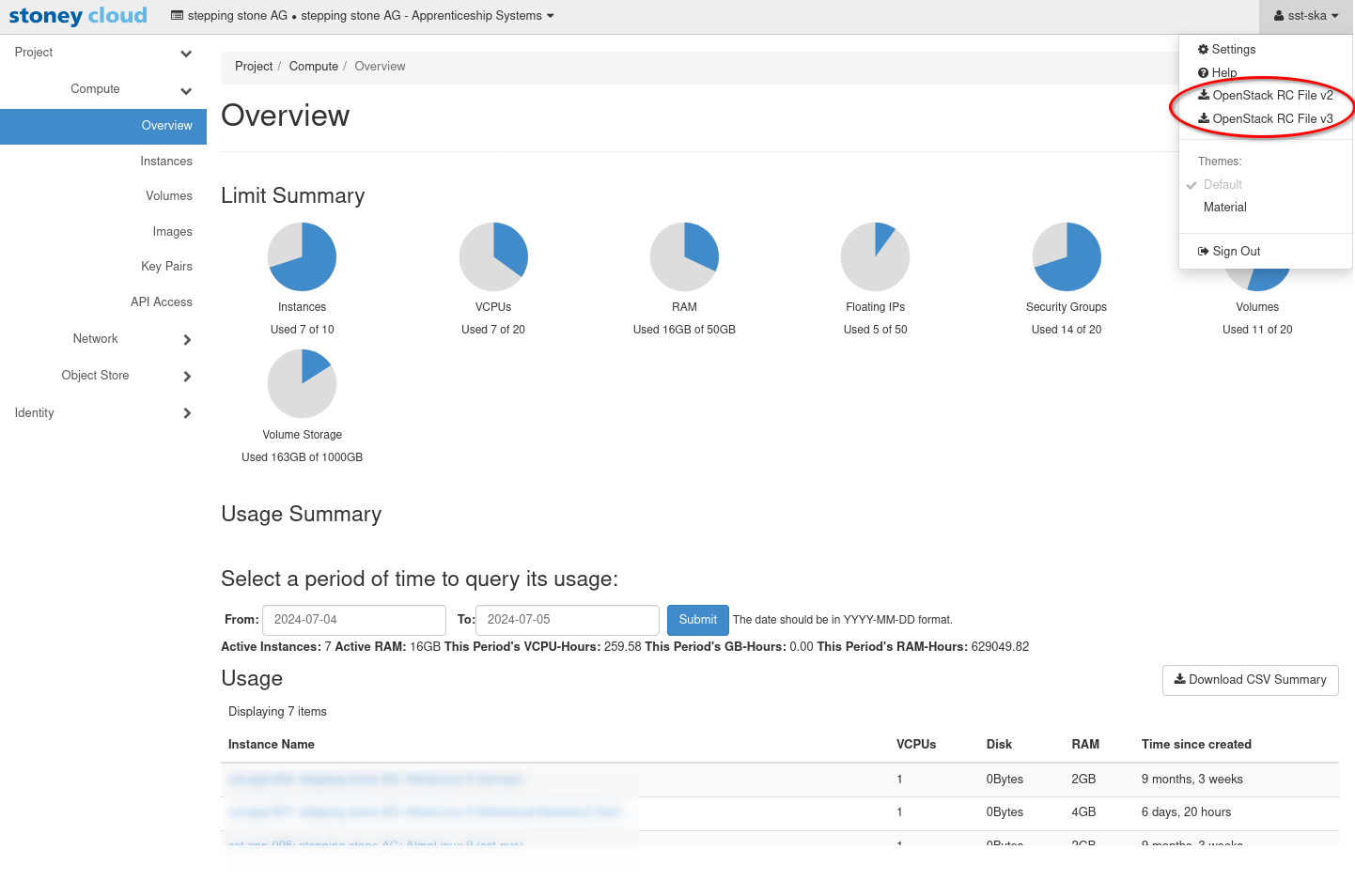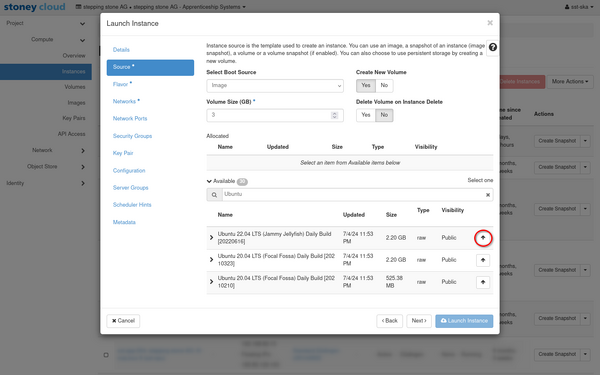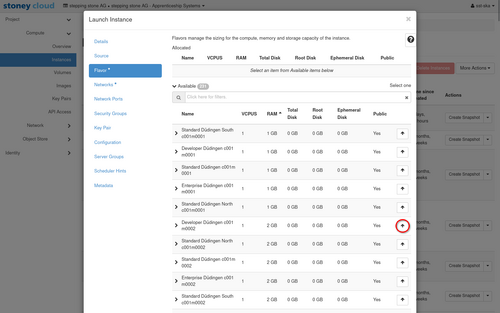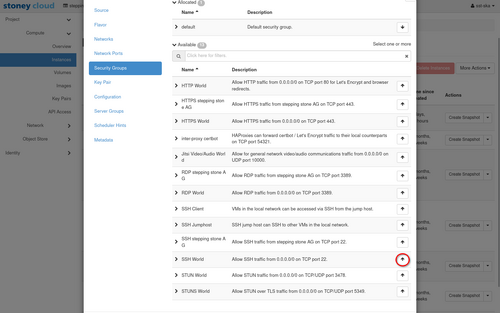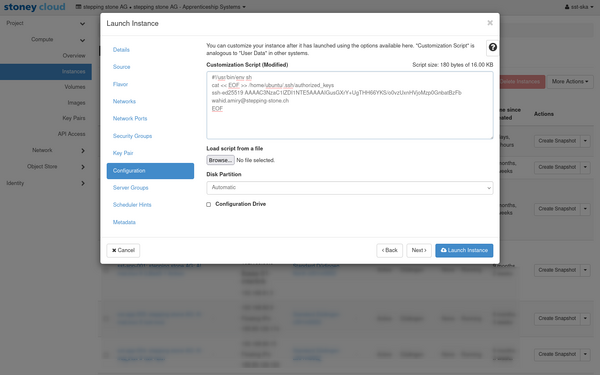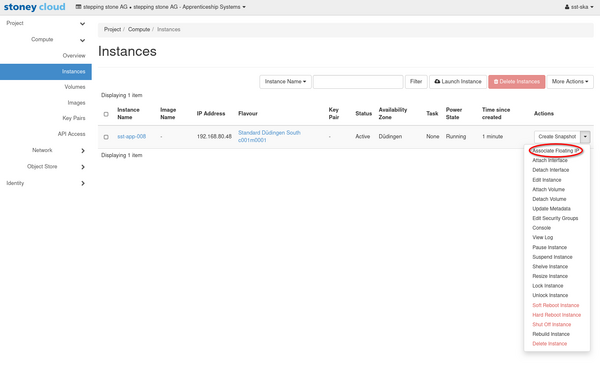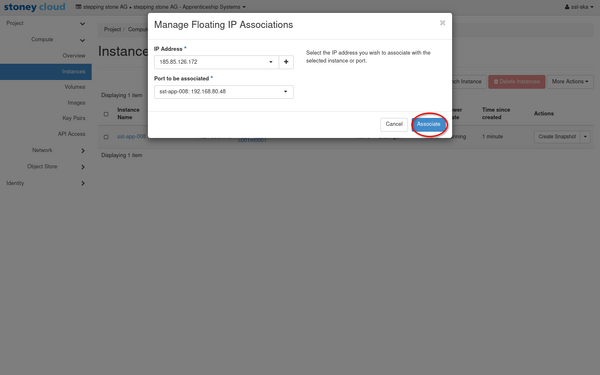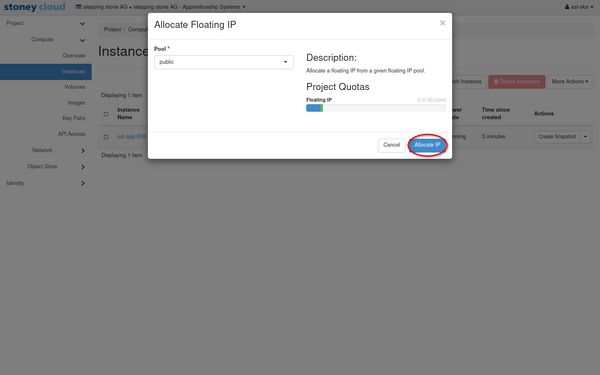VM creation (Linux): Difference between revisions
No edit summary |
No edit summary |
||
| Line 1: | Line 1: | ||
= VM creation = | |||
= Cluster Operations = | |||
== Cluster Operations - Creating == | |||
<tabber> | |||
|-|VM creation CLI= | |||
= OpenStack CLI Installation = | |||
To use OpenStack CLI, you need to install the OpenStack CLI Client for your OS: | |||
<syntaxhighlight lang="bash"> | |||
# Fedora | |||
dnf install python3-openstackclient | |||
# Debian / Ubuntu | |||
apt install python3-openstackclient | |||
</syntaxhighlight> | |||
The official installaton guide can be found on [https://docs.openstack.org/mitaka/user-guide/common/cli_install_openstack_command_line_clients.html docs.openstack.org]. | |||
= OpenStack client environment script (OpenRC file) = | |||
To increase efficiency of client operations, OpenStack supports simple client environment scripts also known as OpenRC files. These scripts typically contain common options for all clients, but also support unique options. | |||
You may download such an OpenRC file from the [https://dashboard.stoney-cloud.com/ dashboard]. | |||
After logging into the [https://dashboard.stoney-cloud.com/ dashboard], click on your user name in the upper right corner and choose the menu option «OpenStack RC File v3» and save it the desired location on your local machine. As you can have multiple OpenRC files, we recommend to use a sub directory. For example <code>openrc</code> in your home directory. | |||
[[Image:OpenStack_RC_File_v3.png]] | |||
Source the OpenRC file specific to this project (use single quotation marks to avoid problems with spaces in the file name): | |||
<syntaxhighlight lang='bash'> | |||
source ${HOME}/openrc/'Project Name-openrc.sh' | |||
</syntaxhighlight> | |||
After you sourced the file, you need to enter a password: | |||
<syntaxhighlight lang="text"> | |||
Please enter your OpenStack Password for project Project Name as user user: | |||
</syntaxhighlight> | |||
Check if you have access to the OpenStack API by listing the API endpoints: | |||
<syntaxhighlight lang='bash'> | |||
openstack catalog list | |||
</syntaxhighlight> | |||
Expected output: | |||
<syntaxhighlight lang='text'> | |||
+------------+-----------+--------------------------------------------------------------------------------------------------+ | |||
| Name | Type | Endpoints | | |||
+------------+-----------+--------------------------------------------------------------------------------------------------+ | |||
| glance | image | duedingen-production | | |||
| | | internal: https://glance.ctrl-int.os.stoney-cloud.com:9292 | | |||
| | | duedingen-production | | |||
| | | public: https://api.os.stoney-cloud.com:9292 | | |||
| | | duedingen-production | | |||
| | | admin: https://glance.ctrl-int.os.stoney-cloud.com:9292 | | |||
[...] | |||
| cinderv2 | volumev2 | duedingen-production | | |||
| | | internal: https://cinder.ctrl-int.os.stoney-cloud.com:8776/v2/616812eda14e44de89138f3377841187 | | |||
| | | duedingen-production | | |||
| | | admin: https://cinder.ctrl-int.os.stoney-cloud.com:8776/v2/616812eda14e44de89138f3377841187 | | |||
| | | duedingen-production | | |||
| | | public: https://api.os.stoney-cloud.com:8776/v2/616812eda14e44de89138f3377841187 | | |||
| | | | | |||
+------------+-----------+--------------------------------------------------------------------------------------------------+ | |||
</syntaxhighlight> | |||
= VM Creation - One-Disk Setup = | |||
== VM Creation - One-Disk Setup - Variables == | |||
We define bash variables so that in every command the same value is being used. | |||
Another advantage of variables is, that the documentation is significantly easier, as another person could replicate the server if they know the variables that were set. | |||
Set the following variables that we will use in later commands: | |||
<syntaxhighlight lang='bash'> | |||
# Host name of the server. Example: hostname="sst-int-tmp-041" | |||
hostname="" | |||
# Display name of the server in OpenStack. Example: vmname="sst-int-tmp-041: debian test cli" | |||
vmname="" | |||
# Domain name. Example: domain="os.stoney-cloud.com" | |||
domain="" | |||
</syntaxhighlight> | |||
We need to set the <code>project_id</code> variable to the project our previously sourced openrc file belongs to: | |||
<syntaxhighlight lang='bash'> | |||
# List the projects of your OpenStack domain. | |||
openstack project list | |||
# Project ID of the project in which the VM will be created. | |||
# Example (stepping stone AG - Internal Systems Temporary): project_id="6fd0ccd8b5ae44d292c67f0d3e75ca20" | |||
project_id="" | |||
</syntaxhighlight> | |||
A flavour defines the CPU and RAM resources of the VM. | |||
The flavour is in the following format: <code>cXXmYYYY</code> where <code>XX</code> is the amount of CPUs and <code>YYYY</code> the about of RAM: | |||
<syntaxhighlight lang='bash'> | |||
# List all available flavors | |||
openstack flavor list --column Name --column ID | tail -n+3 | head -n-1 | sort -k3 -t'|' | |||
# Set the flavor ID, default: Standard Düdingen c001m0004 (719c82d4-df94-47fc-a7df-f18d5c6d3727). | |||
# Example: flavor_id="719c82d4-df94-47fc-a7df-f18d5c6d3727" | |||
flavor_id="" | |||
</syntaxhighlight> | |||
We will add our VM to the <code>internal</code> network of our project. This is the default network: | |||
<syntaxhighlight lang='bash'> | |||
# List the networks of the current project | |||
openstack network list --project ${project_id} | |||
# Network ID, usually the ID for the network "internal". | |||
# Example: network_id="919c2dde-6996-494a-86de-fc3b08248418" | |||
network_id="" | |||
</syntaxhighlight> | |||
For this example, we use the "SSH" and "default" security groups (firewall-rules), so that we can access our server via ssh: | |||
<syntaxhighlight lang='bash'> | |||
# List the security groups of the current project and search for ssh and default | |||
openstack security group list --project ${project_id} | egrep -i '(ssh|default)' | |||
# We set the default security group ID "default" ("default" is required for outgoing traffic!): | |||
# Example: default_security_group_id="3f576bd2-11fe-47f3-806e-aaa219cff589" # default | |||
default_security_group_id="" | |||
# We set the "SSH World" security group ID: | |||
# Example: ssh_security_group_id="8083a9f3-e6c0-4061-b4bb-eb0dd24a86ef" # SSH World | |||
ssh_security_group_id="" | |||
</syntaxhighlight> | |||
== VM Creation - One-Disk Setup - Disk creation == | |||
In OpenStack every Image has an ID. | |||
To create a new VM, we need to create a disk first. | |||
We can list the available images using the openstack-cli - we search for Ubuntu: | |||
<syntaxhighlight lang='bash'> | |||
openstack image list | grep "Ubuntu" | |||
</syntaxhighlight> | |||
Expected output: | |||
<syntaxhighlight lang='text'> | |||
| 0ebe72db-55cf-4caa-ac47-a08994e7f163 | Ubuntu 20.04 LTS (Focal Fossa) Daily Build [20210210] | active | | |||
| 18d38120-873e-4902-850d-ce7be3a62d93 | Ubuntu 20.04 LTS (Focal Fossa) Daily Build [20210323] | active | | |||
| 50735f95-4963-4994-9c65-dac44773977b | Ubuntu 22.04 LTS (Jammy Jellyfish) Daily Build [20220616] | active | | |||
</syntaxhighlight> | |||
We set the ID of the image and the size of the disk as variables for later use. | |||
<syntaxhighlight lang='bash'> | |||
# Set the Image ID used for the first volume (Ubuntu 22.04 LTS (Jammy Jellyfish) Daily Build [20220616]) | |||
vda_image_id="50735f95-4963-4994-9c65-dac44773977b" | |||
# Size for the first volume in GiB | |||
volume_size_vda="10" | |||
</syntaxhighlight> | |||
Now we can create the volume using the variables we just set. | |||
We can set <code>volume_vda_id</code> as the command returns the ID of the newly created disk: | |||
{| style="background-color:rgba(255,0,0,0);border-width:0px;" | |||
| | |||
<syntaxhighlight lang='bash'> | |||
volume_vda_id=$( | |||
openstack volume create \ | |||
--property os-vol-tenant-attr:tenant_id=${project_id} \ | |||
--bootable \ | |||
--size ${volume_size_vda} \ | |||
--image ${vda_image_id} \ | |||
--description "OS disk (/dev/vda) for ${hostname}." \ | |||
--column id \ | |||
--format value \ | |||
"${hostname}: OS" | |||
) | |||
</syntaxhighlight> | |||
| | |||
<syntaxhighlight lang='bash' line='line' > | |||
Set the variable ${volume_vda_id}. | |||
Creates a new disk. | |||
The disk belongs to the current project. | |||
The disk can be bootable. | |||
The size of the disk is ${volume_size_vda}. | |||
The image of the disk is ${vda_image_id. | |||
We set the description of the disk. | |||
The id column will be printed out as output. | |||
Only the value will be printed out as output. | |||
Name of the disk. | |||
- | |||
</syntaxhighlight> | |||
|} | |||
We ask OpenStack for the status of the current disk. | |||
If the disk has been successfully created, we can move on and create the VM: | |||
<syntaxhighlight lang='bash'> | |||
openstack volume show \ | |||
"${volume_vda_id}" \ | |||
--column status \ | |||
--format value | |||
</syntaxhighlight> | |||
Expected output: | |||
<syntaxhighlight lang='text'> | |||
available | |||
</syntaxhighlight> | |||
== VM Creation - One-Disk Setup - VM creation == | |||
We create a configuration file. In it, we can define the hostname of the server as well as commands that will be ran on startup. | |||
We also add our ssh public keys to this file. | |||
<syntaxhighlight lang='bash'> | |||
# Create a folder for the cloud-init files. | |||
mkdir -p ${HOME}/openstack | |||
</syntaxhighlight> | |||
The following command creates a cloud-config file in <code>${HOME}/openstack/${hostname}.cloud-init</code>. '''Replace''' the '''ssh public keys''' with your own! | |||
'''IMPORTANT: The newest Ubuntu Version does not accept ssh-rsa and ssh-dss keys by default. We must use a ed25519 key!''' | |||
<syntaxhighlight lang='bash'> | |||
cat <<EOF > ${HOME}/openstack/${hostname}.cloud-init | |||
#cloud-config | |||
hostname: ${hostname} | |||
fqdn: ${hostname}.${domain} | |||
runcmd: | |||
- [ ln, "--symbolic", "--force", "../usr/share/zoneinfo/Europe/Zurich", "/etc/localtime" ] | |||
ssh_authorized_keys: | |||
- "ssh-ed25519 AAAAC3NzaC1lZDI1NTE5AAAAIAQpBvIVaGryODNUG0MzqSIUy6TM8fasewZUEMVyFpmN alain.sinzig@stepping-stone.ch" | |||
- "ssh-ed25519 AAAAC3NzaC1lZDI1NTE5AAAAIGusGXrY+UgTHH66YKS/o0vzUxnHVjoMzp0GnbatBzFb wahid.amiry@stepping-stone.ch" | |||
- "ssh-ed25519 AAAAC3NzaC1lZDI1NTE5AAAAIMIHnEB/9uqcJ4P+i6kMrfjt11HBnmgbDodHh5zqEXAa fabian.zoffel@stepping-stone.ch" | |||
- "ssh-ed25519 AAAAC3NzaC1lZDI1NTE5AAAAICK+4kHiDYdb2CzvY9CTLiWpJ33c0cyDP+sZJUlvc3+N niklaus.hofer@stepping-stone.ch" | |||
- "ssh-ed25519 AAAAC3NzaC1lZDI1NTE5AAAAIKb6iBxDn/IPnuHU81HPxaw9Gp/coE27C2Y9n12K8K0p yannick.denzer@stepping-stone.ch" | |||
- "ssh-ed25519 AAAAC3NzaC1lZDI1NTE5AAAAIHSTJu9OiQLi+kwfg77mVuzs7V5ildZL0b/u5PquQ01w michael.eichenberger@stepping-stone.ch" | |||
EOF | |||
</syntaxhighlight> | |||
The script links the correct time zone to <code>/etc/localtime</code> and adds the public keys. | |||
Review the cloud-init file: | |||
<syntaxhighlight lang='bash'> | |||
${EDITOR} ${HOME}/openstack/${hostname}.cloud-init | |||
</syntaxhighlight> | |||
Finally, we can create the server using the <code>openstack server create</code> command: | |||
{| | |||
| | |||
<syntaxhighlight lang='bash'> | |||
server_id=$( | |||
openstack server create \ | |||
--property project_id=${project_id} \ | |||
--flavor "${flavor_id}" \ | |||
--nic "net-id=${network_id}" \ | |||
--volume "${volume_vda_id}" \ | |||
--security-group "${default_security_group_id}" \ | |||
--security-group "${ssh_security_group_id}" \ | |||
--user-data ${HOME}/openstack/${hostname}.cloud-init \ | |||
--column id \ | |||
--format value \ | |||
"${vmname}" | |||
) | |||
</syntaxhighlight> | |||
| | |||
<syntaxhighlight lang='text' line='line'> | |||
We set the server_id variable to the OpenStack id of the server. | |||
We create a new VM. | |||
We set the project to ${project_id}. | |||
We set the flavor to ${flavor_id}. | |||
We set the nic to ${network_id}. | |||
We set the volume to ${volume_vda_id}. | |||
Use the security-group (firwall rule) ${default_security_group_id}. | |||
Use the security-group (firwall rule) ${ssh_security_group_id}. | |||
We use our previously generated clopud init script as user-data. | |||
The id column will be printed out as output. | |||
Only the value will be printed out as output. | |||
We set the name of the VM. | |||
- | |||
</syntaxhighlight> | |||
|} | |||
Check the status of the newly created instance (should be ACTIVE) | |||
<syntaxhighlight lang='bash'> | |||
openstack server show ${server_id} --column status | |||
</syntaxhighlight> | |||
Expected Output: | |||
<syntaxhighlight lang='text'> | |||
+--------+--------+ | |||
| Field | Value | | |||
+--------+--------+ | |||
| status | ACTIVE | | |||
+--------+--------+ | |||
</syntaxhighlight> | |||
== VM Creation - One-Disk Setup - Floating IP == | |||
Create a floating IP: | |||
<syntaxhighlight lang="bash"> | |||
floating_ip_id=$( | |||
openstack floating ip create \ | |||
--column id \ | |||
--format value \ | |||
public | |||
) | |||
</syntaxhighlight> | |||
Get the IP-Adress of the newly created VM and output it: | |||
<syntaxhighlight lang="bash"> | |||
floating_ip=$( | |||
openstack floating ip show \ | |||
--column floating_ip_address \ | |||
--format value \ | |||
"${floating_ip_id}" | |||
) | |||
echo ${floating_ip} | |||
</syntaxhighlight> | |||
Assign that floating IP to the newly created VM: | |||
<syntaxhighlight lang="bash"> | |||
openstack server add floating ip \ | |||
"${server_id}" \ | |||
"${floating_ip}" | |||
</syntaxhighlight> | |||
== VM Creation - One-Disk Setup - VM Login == | |||
Finally, you can connect to your newly created VM: | |||
<syntaxhighlight lang='bash'> | |||
ssh ubuntu@${floating_ip} | |||
</syntaxhighlight> | |||
Expected output: | |||
<syntaxhighlight lang='text'> | |||
The authenticity of host '185.85.126.34 (185.85.126.34)' can't be established. | |||
ED25519 key fingerprint is SHA256:lviEBYSl+ij7KJmKxmsDzkkPjgUCA9K4hB+3ES0LSn8. | |||
This key is not known by any other names | |||
Are you sure you want to continue connecting (yes/no/[fingerprint])? yes | |||
Warning: Permanently added '185.85.126.34' (ED25519) to the list of known hosts. | |||
Welcome to Ubuntu 22.04 LTS (GNU/Linux 5.15.0-39-generic x86_64) | |||
[...] | |||
To run a command as administrator (user "root"), use "sudo <command>". | |||
See "man sudo_root" for details. | |||
ubuntu@hostname:~$ | |||
</syntaxhighlight> | |||
== VM Creation - One-Disk Setup - Checks == | |||
Become root: | |||
<syntaxhighlight lang='bash'> | |||
sudo -i | |||
</syntaxhighlight> | |||
Check if the correct image was selected: | |||
<syntaxhighlight lang='bash'> | |||
# Check the OS | |||
cat /etc/os-release | |||
</syntaxhighlight> | |||
<syntaxhighlight lang='text'> | |||
PRETTY_NAME="Ubuntu 22.04 LTS" | |||
NAME="Ubuntu" | |||
VERSION_ID="22.04" | |||
VERSION="22.04 LTS (Jammy Jellyfish)" | |||
VERSION_CODENAME=jammy | |||
ID=ubuntu | |||
ID_LIKE=debian | |||
HOME_URL="https://www.ubuntu.com/" | |||
SUPPORT_URL="https://help.ubuntu.com/" | |||
BUG_REPORT_URL="https://bugs.launchpad.net/ubuntu/" | |||
PRIVACY_POLICY_URL="https://www.ubuntu.com/legal/terms-and-policies/privacy-policy" | |||
UBUNTU_CODENAME=jammy | |||
</syntaxhighlight> | |||
Check if the disks are mounted correctly: | |||
<syntaxhighlight lang='bash'> | |||
# Check the block devices | |||
lsblk | |||
</syntaxhighlight> | |||
<syntaxhighlight lang='text'> | |||
NAME MAJ:MIN RM SIZE RO TYPE MOUNTPOINTS | |||
loop0 7:0 0 61.9M 1 loop /snap/core20/1518 | |||
loop1 7:1 0 79.9M 1 loop /snap/lxd/22923 | |||
loop2 7:2 0 47M 1 loop /snap/snapd/16010 | |||
vda 252:0 0 10G 0 disk | |||
├─vda1 252:1 0 9.9G 0 part / | |||
├─vda14 252:14 0 4M 0 part | |||
└─vda15 252:15 0 106M 0 part /boot/efi | |||
</syntaxhighlight> | |||
<syntaxhighlight lang='bash'> | |||
# Check the disks | |||
df -h | |||
</syntaxhighlight> | |||
<syntaxhighlight lang='text'> | |||
Filesystem Size Used Avail Use% Mounted on | |||
tmpfs 393M 1016K 392M 1% /run | |||
/dev/vda1 9.6G 1.4G 8.2G 15% / | |||
tmpfs 2.0G 0 2.0G 0% /dev/shm | |||
tmpfs 5.0M 0 5.0M 0% /run/lock | |||
/dev/vda15 105M 5.3M 100M 5% /boot/efi | |||
tmpfs 393M 4.0K 393M 1% /run/user/1000 | |||
</syntaxhighlight> | |||
Check if you selected the correct flavour: | |||
<syntaxhighlight lang='bash'> | |||
# Check the numbers cpus | |||
nproc | |||
</syntaxhighlight> | |||
<syntaxhighlight lang='text'> | |||
1 | |||
</syntaxhighlight> | |||
<syntaxhighlight lang='bash'> | |||
# Check the amount of RAM | |||
free -h | |||
</syntaxhighlight> | |||
<syntaxhighlight lang='text'> | |||
total used free shared buff/cache available | |||
Mem: 3.8Gi 193Mi 3.3Gi 0.0Ki 331Mi 3.4Gi | |||
Swap: 0B 0B 0B | |||
</syntaxhighlight> | |||
|-|VM creation Dashboard= | |||
== Overview == | |||
This page describes the steps for creating a Ubuntu 22.04 LTS (Jammy Jellyfish) VM via horizon Dashboard. | |||
== VM Creation == | |||
=== VM Creation - Login via Dashboard === | |||
Log in to the stoney cloud [https://dashboard.stoney-cloud.com/dashboard dashboard] with the credentials you have received from us. | |||
[[File:Debian VM Creation Dashboard manual 01.png|400px]] | |||
=== VM Creation - Launch Instance - Preperations === | |||
1. Select the appropriate project from the drop down menu at the top left. | |||
3. On the <code>Project</code> tab, open the <code>Compute tab</code> and click <code>Instances</code> category. | |||
4. Click <code>Launch Instance</code>. | |||
[[File:Debian VM Creation Dashboard manual 02.png|800px]] | |||
5. A dialog box opens. Specify the values as follows: | |||
* '''Instance Name''': Assign a name to the virtual machine. | |||
* Click <code>Source</code> tab and chose '''Image''' in '''Select Boot Source'''. | |||
* Type '''Ubuntu''' in the search bar below and allocate the image 'Ubuntu 22.04 LTS (Jammy Jellyfish) Daily Build [20220616]' from the image list by clicking the arrow pointing up. | |||
[[File:Ubuntu VM Creation Dashboard manual 01.png|600px]] | |||
* Click <code>Flavour</code> tab and allocate the desired Flavour (For example: Standard Düdingen c001m0002) from the list below by clicking the arrow pointing up. | |||
[[File:Debian VM Creation Dashboard manual 04.png|500px]] | |||
* Click <code>Security Groups</code> and allocate the security group '''SSH Client''' from the list below by clicking the arrow pointing up. | |||
[[File:Debian VM Creation Dashboard manual 05.png|500px]] | |||
=== VM Creation - Launch Instance - Add Public Key === | |||
The newest Ubuntu Version does not accept ssh-rsa and ssh-dss keys by default. '''You must use a ed25519 key!''' | |||
Click <code>Configuration</code> tab and paste the following into the '''Customization Script (Modified)''' field. Replace the ssh public key with your own. | |||
<syntaxhighlight lang="bash"> | |||
#!/usr/bin/env sh | |||
cat << EOF >> /home/ubuntu/.ssh/authorized_keys | |||
ssh-ed25519 AAAAC3NzaC1lZDI1NTE5AAAAIGusGXrY+UgTHH66YKS/o0vzUxnHVjoMzp0GnbatBzFb wahid.amiry@stepping-stone.ch | |||
EOF | |||
</syntaxhighlight> | |||
[[File:Ubuntu VM Creation Dashboard manual 02.png|600px]] | |||
Click<code>Launch Instance</code> to create the VM. After no more than a minute the VM is created and listed in the <code>Instances</code> page. | |||
[[File:Ubuntu VM Creation Dashboard manual 03.png|800px]] | |||
=== VM Creation - Floating IP === | |||
In the<code>Instances</code> page go to the '''Actions''' column on the top right and select '''Associate Floating IP'''. | |||
[[File:Ubuntu VM Creation Dashboard manual 04.png|600px]] | |||
A dialog box appears. Select an available IP address and click on '''Associate''' to assign a Floating IP to the VM | |||
[[File:Ubuntu VM Creation Dashboard manual 05.png|600px]] | |||
If there are not available IP addresses, create a new one by clicking on the '+' sign and click on '''Allocate IP'''. | |||
[[File:Ubuntu VM Creation Dashboard manual 06.png|600px]] | |||
=== VM Creation - VM Login === | |||
Finally, you can connect to your newly created VM: | |||
<syntaxhighlight lang='bash'> | |||
ssh ubuntu@185.85.126.29 | |||
</syntaxhighlight> | |||
Expected output: | |||
<syntaxhighlight lang='text'> | |||
The authenticity of host '185.85.126.29 (185.85.126.29)' can't be established. | |||
ED25519 key fingerprint is SHA256:UhyGZCGExlSN8aldY+PWtnYyxiG5XGh1YRpH1IeWsdU. | |||
This key is not known by any other names | |||
Are you sure you want to continue connecting (yes/no/[fingerprint])? yes | |||
Warning: Permanently added '185.85.126.29' (ED25519) to the list of known hosts. | |||
Enter passphrase for key '/home/sst-wam/.ssh/id_ed25519': | |||
Welcome to Ubuntu 22.04 LTS (GNU/Linux 5.15.0-39-generic x86_64) | |||
[...] | |||
To run a command as administrator (user "root"), use "sudo <command>". | |||
See "man sudo_root" for details. | |||
ubuntu@hsst-int-tmp-038:~$ | |||
</syntaxhighlight> | |||
[[Category: Instances]] | [[Category: Instances]] | ||
Revision as of 10:43, 1 July 2024
VM creation
Cluster Operations
Cluster Operations - Creating
<tabber> |-|VM creation CLI=
OpenStack CLI Installation
To use OpenStack CLI, you need to install the OpenStack CLI Client for your OS:
# Fedora
dnf install python3-openstackclient
# Debian / Ubuntu
apt install python3-openstackclient
The official installaton guide can be found on docs.openstack.org.
OpenStack client environment script (OpenRC file)
To increase efficiency of client operations, OpenStack supports simple client environment scripts also known as OpenRC files. These scripts typically contain common options for all clients, but also support unique options.
You may download such an OpenRC file from the dashboard.
After logging into the dashboard, click on your user name in the upper right corner and choose the menu option «OpenStack RC File v3» and save it the desired location on your local machine. As you can have multiple OpenRC files, we recommend to use a sub directory. For example openrc in your home directory.
Source the OpenRC file specific to this project (use single quotation marks to avoid problems with spaces in the file name):
source ${HOME}/openrc/'Project Name-openrc.sh'
After you sourced the file, you need to enter a password:
Please enter your OpenStack Password for project Project Name as user user:
Check if you have access to the OpenStack API by listing the API endpoints:
openstack catalog list
Expected output:
+------------+-----------+--------------------------------------------------------------------------------------------------+
| Name | Type | Endpoints |
+------------+-----------+--------------------------------------------------------------------------------------------------+
| glance | image | duedingen-production |
| | | internal: https://glance.ctrl-int.os.stoney-cloud.com:9292 |
| | | duedingen-production |
| | | public: https://api.os.stoney-cloud.com:9292 |
| | | duedingen-production |
| | | admin: https://glance.ctrl-int.os.stoney-cloud.com:9292 |
[...]
| cinderv2 | volumev2 | duedingen-production |
| | | internal: https://cinder.ctrl-int.os.stoney-cloud.com:8776/v2/616812eda14e44de89138f3377841187 |
| | | duedingen-production |
| | | admin: https://cinder.ctrl-int.os.stoney-cloud.com:8776/v2/616812eda14e44de89138f3377841187 |
| | | duedingen-production |
| | | public: https://api.os.stoney-cloud.com:8776/v2/616812eda14e44de89138f3377841187 |
| | | |
+------------+-----------+--------------------------------------------------------------------------------------------------+
VM Creation - One-Disk Setup
VM Creation - One-Disk Setup - Variables
We define bash variables so that in every command the same value is being used.
Another advantage of variables is, that the documentation is significantly easier, as another person could replicate the server if they know the variables that were set.
Set the following variables that we will use in later commands:
# Host name of the server. Example: hostname="sst-int-tmp-041"
hostname=""
# Display name of the server in OpenStack. Example: vmname="sst-int-tmp-041: debian test cli"
vmname=""
# Domain name. Example: domain="os.stoney-cloud.com"
domain=""
We need to set the project_id variable to the project our previously sourced openrc file belongs to:
# List the projects of your OpenStack domain.
openstack project list
# Project ID of the project in which the VM will be created.
# Example (stepping stone AG - Internal Systems Temporary): project_id="6fd0ccd8b5ae44d292c67f0d3e75ca20"
project_id=""
A flavour defines the CPU and RAM resources of the VM.
The flavour is in the following format: cXXmYYYY where XX is the amount of CPUs and YYYY the about of RAM:
# List all available flavors
openstack flavor list --column Name --column ID | tail -n+3 | head -n-1 | sort -k3 -t'|'
# Set the flavor ID, default: Standard Düdingen c001m0004 (719c82d4-df94-47fc-a7df-f18d5c6d3727).
# Example: flavor_id="719c82d4-df94-47fc-a7df-f18d5c6d3727"
flavor_id=""
We will add our VM to the internal network of our project. This is the default network:
# List the networks of the current project
openstack network list --project ${project_id}
# Network ID, usually the ID for the network "internal".
# Example: network_id="919c2dde-6996-494a-86de-fc3b08248418"
network_id=""
For this example, we use the "SSH" and "default" security groups (firewall-rules), so that we can access our server via ssh:
# List the security groups of the current project and search for ssh and default
openstack security group list --project ${project_id} | egrep -i '(ssh|default)'
# We set the default security group ID "default" ("default" is required for outgoing traffic!):
# Example: default_security_group_id="3f576bd2-11fe-47f3-806e-aaa219cff589" # default
default_security_group_id=""
# We set the "SSH World" security group ID:
# Example: ssh_security_group_id="8083a9f3-e6c0-4061-b4bb-eb0dd24a86ef" # SSH World
ssh_security_group_id=""
VM Creation - One-Disk Setup - Disk creation
In OpenStack every Image has an ID.
To create a new VM, we need to create a disk first.
We can list the available images using the openstack-cli - we search for Ubuntu:
openstack image list | grep "Ubuntu"
Expected output:
| 0ebe72db-55cf-4caa-ac47-a08994e7f163 | Ubuntu 20.04 LTS (Focal Fossa) Daily Build [20210210] | active |
| 18d38120-873e-4902-850d-ce7be3a62d93 | Ubuntu 20.04 LTS (Focal Fossa) Daily Build [20210323] | active |
| 50735f95-4963-4994-9c65-dac44773977b | Ubuntu 22.04 LTS (Jammy Jellyfish) Daily Build [20220616] | active |
We set the ID of the image and the size of the disk as variables for later use.
# Set the Image ID used for the first volume (Ubuntu 22.04 LTS (Jammy Jellyfish) Daily Build [20220616])
vda_image_id="50735f95-4963-4994-9c65-dac44773977b"
# Size for the first volume in GiB
volume_size_vda="10"
Now we can create the volume using the variables we just set.
We can set volume_vda_id as the command returns the ID of the newly created disk:
volume_vda_id=$(
openstack volume create \
--property os-vol-tenant-attr:tenant_id=${project_id} \
--bootable \
--size ${volume_size_vda} \
--image ${vda_image_id} \
--description "OS disk (/dev/vda) for ${hostname}." \
--column id \
--format value \
"${hostname}: OS"
)
|
Set the variable ${volume_vda_id}.
Creates a new disk.
The disk belongs to the current project.
The disk can be bootable.
The size of the disk is ${volume_size_vda}.
The image of the disk is ${vda_image_id.
We set the description of the disk.
The id column will be printed out as output.
Only the value will be printed out as output.
Name of the disk.
-
|
We ask OpenStack for the status of the current disk.
If the disk has been successfully created, we can move on and create the VM:
openstack volume show \
"${volume_vda_id}" \
--column status \
--format value
Expected output:
available
VM Creation - One-Disk Setup - VM creation
We create a configuration file. In it, we can define the hostname of the server as well as commands that will be ran on startup. We also add our ssh public keys to this file.
# Create a folder for the cloud-init files.
mkdir -p ${HOME}/openstack
The following command creates a cloud-config file in ${HOME}/openstack/${hostname}.cloud-init. Replace the ssh public keys with your own!
IMPORTANT: The newest Ubuntu Version does not accept ssh-rsa and ssh-dss keys by default. We must use a ed25519 key!
cat <<EOF > ${HOME}/openstack/${hostname}.cloud-init
#cloud-config
hostname: ${hostname}
fqdn: ${hostname}.${domain}
runcmd:
- [ ln, "--symbolic", "--force", "../usr/share/zoneinfo/Europe/Zurich", "/etc/localtime" ]
ssh_authorized_keys:
- "ssh-ed25519 AAAAC3NzaC1lZDI1NTE5AAAAIAQpBvIVaGryODNUG0MzqSIUy6TM8fasewZUEMVyFpmN alain.sinzig@stepping-stone.ch"
- "ssh-ed25519 AAAAC3NzaC1lZDI1NTE5AAAAIGusGXrY+UgTHH66YKS/o0vzUxnHVjoMzp0GnbatBzFb wahid.amiry@stepping-stone.ch"
- "ssh-ed25519 AAAAC3NzaC1lZDI1NTE5AAAAIMIHnEB/9uqcJ4P+i6kMrfjt11HBnmgbDodHh5zqEXAa fabian.zoffel@stepping-stone.ch"
- "ssh-ed25519 AAAAC3NzaC1lZDI1NTE5AAAAICK+4kHiDYdb2CzvY9CTLiWpJ33c0cyDP+sZJUlvc3+N niklaus.hofer@stepping-stone.ch"
- "ssh-ed25519 AAAAC3NzaC1lZDI1NTE5AAAAIKb6iBxDn/IPnuHU81HPxaw9Gp/coE27C2Y9n12K8K0p yannick.denzer@stepping-stone.ch"
- "ssh-ed25519 AAAAC3NzaC1lZDI1NTE5AAAAIHSTJu9OiQLi+kwfg77mVuzs7V5ildZL0b/u5PquQ01w michael.eichenberger@stepping-stone.ch"
EOF
The script links the correct time zone to /etc/localtime and adds the public keys.
Review the cloud-init file:
${EDITOR} ${HOME}/openstack/${hostname}.cloud-init
Finally, we can create the server using the openstack server create command:
server_id=$(
openstack server create \
--property project_id=${project_id} \
--flavor "${flavor_id}" \
--nic "net-id=${network_id}" \
--volume "${volume_vda_id}" \
--security-group "${default_security_group_id}" \
--security-group "${ssh_security_group_id}" \
--user-data ${HOME}/openstack/${hostname}.cloud-init \
--column id \
--format value \
"${vmname}"
)
|
We set the server_id variable to the OpenStack id of the server.
We create a new VM.
We set the project to ${project_id}.
We set the flavor to ${flavor_id}.
We set the nic to ${network_id}.
We set the volume to ${volume_vda_id}.
Use the security-group (firwall rule) ${default_security_group_id}.
Use the security-group (firwall rule) ${ssh_security_group_id}.
We use our previously generated clopud init script as user-data.
The id column will be printed out as output.
Only the value will be printed out as output.
We set the name of the VM.
-
|
Check the status of the newly created instance (should be ACTIVE)
openstack server show ${server_id} --column status
Expected Output:
+--------+--------+
| Field | Value |
+--------+--------+
| status | ACTIVE |
+--------+--------+
VM Creation - One-Disk Setup - Floating IP
Create a floating IP:
floating_ip_id=$(
openstack floating ip create \
--column id \
--format value \
public
)
Get the IP-Adress of the newly created VM and output it:
floating_ip=$(
openstack floating ip show \
--column floating_ip_address \
--format value \
"${floating_ip_id}"
)
echo ${floating_ip}
Assign that floating IP to the newly created VM:
openstack server add floating ip \
"${server_id}" \
"${floating_ip}"
VM Creation - One-Disk Setup - VM Login
Finally, you can connect to your newly created VM:
ssh ubuntu@${floating_ip}
Expected output:
The authenticity of host '185.85.126.34 (185.85.126.34)' can't be established.
ED25519 key fingerprint is SHA256:lviEBYSl+ij7KJmKxmsDzkkPjgUCA9K4hB+3ES0LSn8.
This key is not known by any other names
Are you sure you want to continue connecting (yes/no/[fingerprint])? yes
Warning: Permanently added '185.85.126.34' (ED25519) to the list of known hosts.
Welcome to Ubuntu 22.04 LTS (GNU/Linux 5.15.0-39-generic x86_64)
[...]
To run a command as administrator (user "root"), use "sudo <command>".
See "man sudo_root" for details.
ubuntu@hostname:~$
VM Creation - One-Disk Setup - Checks
Become root:
sudo -i
Check if the correct image was selected:
# Check the OS
cat /etc/os-release
PRETTY_NAME="Ubuntu 22.04 LTS"
NAME="Ubuntu"
VERSION_ID="22.04"
VERSION="22.04 LTS (Jammy Jellyfish)"
VERSION_CODENAME=jammy
ID=ubuntu
ID_LIKE=debian
HOME_URL="https://www.ubuntu.com/"
SUPPORT_URL="https://help.ubuntu.com/"
BUG_REPORT_URL="https://bugs.launchpad.net/ubuntu/"
PRIVACY_POLICY_URL="https://www.ubuntu.com/legal/terms-and-policies/privacy-policy"
UBUNTU_CODENAME=jammy
Check if the disks are mounted correctly:
# Check the block devices
lsblk
NAME MAJ:MIN RM SIZE RO TYPE MOUNTPOINTS
loop0 7:0 0 61.9M 1 loop /snap/core20/1518
loop1 7:1 0 79.9M 1 loop /snap/lxd/22923
loop2 7:2 0 47M 1 loop /snap/snapd/16010
vda 252:0 0 10G 0 disk
├─vda1 252:1 0 9.9G 0 part /
├─vda14 252:14 0 4M 0 part
└─vda15 252:15 0 106M 0 part /boot/efi
# Check the disks
df -h
Filesystem Size Used Avail Use% Mounted on
tmpfs 393M 1016K 392M 1% /run
/dev/vda1 9.6G 1.4G 8.2G 15% /
tmpfs 2.0G 0 2.0G 0% /dev/shm
tmpfs 5.0M 0 5.0M 0% /run/lock
/dev/vda15 105M 5.3M 100M 5% /boot/efi
tmpfs 393M 4.0K 393M 1% /run/user/1000
Check if you selected the correct flavour:
# Check the numbers cpus
nproc
1
# Check the amount of RAM
free -h
total used free shared buff/cache available
Mem: 3.8Gi 193Mi 3.3Gi 0.0Ki 331Mi 3.4Gi
Swap: 0B 0B 0B
|-|VM creation Dashboard=
Overview
This page describes the steps for creating a Ubuntu 22.04 LTS (Jammy Jellyfish) VM via horizon Dashboard.
VM Creation
VM Creation - Login via Dashboard
Log in to the stoney cloud dashboard with the credentials you have received from us.
VM Creation - Launch Instance - Preperations
1. Select the appropriate project from the drop down menu at the top left.
3. On the Project tab, open the Compute tab and click Instances category.
4. Click Launch Instance.
5. A dialog box opens. Specify the values as follows:
- Instance Name: Assign a name to the virtual machine.
- Click
Sourcetab and chose Image in Select Boot Source. - Type Ubuntu in the search bar below and allocate the image 'Ubuntu 22.04 LTS (Jammy Jellyfish) Daily Build [20220616]' from the image list by clicking the arrow pointing up.
- Click
Flavourtab and allocate the desired Flavour (For example: Standard Düdingen c001m0002) from the list below by clicking the arrow pointing up.
- Click
Security Groupsand allocate the security group SSH Client from the list below by clicking the arrow pointing up.
VM Creation - Launch Instance - Add Public Key
The newest Ubuntu Version does not accept ssh-rsa and ssh-dss keys by default. You must use a ed25519 key!
Click Configuration tab and paste the following into the Customization Script (Modified) field. Replace the ssh public key with your own.
#!/usr/bin/env sh
cat << EOF >> /home/ubuntu/.ssh/authorized_keys
ssh-ed25519 AAAAC3NzaC1lZDI1NTE5AAAAIGusGXrY+UgTHH66YKS/o0vzUxnHVjoMzp0GnbatBzFb wahid.amiry@stepping-stone.ch
EOF
ClickLaunch Instance to create the VM. After no more than a minute the VM is created and listed in the Instances page.
VM Creation - Floating IP
In theInstances page go to the Actions column on the top right and select Associate Floating IP.
A dialog box appears. Select an available IP address and click on Associate to assign a Floating IP to the VM
If there are not available IP addresses, create a new one by clicking on the '+' sign and click on Allocate IP.
VM Creation - VM Login
Finally, you can connect to your newly created VM:
ssh ubuntu@185.85.126.29
Expected output:
The authenticity of host '185.85.126.29 (185.85.126.29)' can't be established.
ED25519 key fingerprint is SHA256:UhyGZCGExlSN8aldY+PWtnYyxiG5XGh1YRpH1IeWsdU.
This key is not known by any other names
Are you sure you want to continue connecting (yes/no/[fingerprint])? yes
Warning: Permanently added '185.85.126.29' (ED25519) to the list of known hosts.
Enter passphrase for key '/home/sst-wam/.ssh/id_ed25519':
Welcome to Ubuntu 22.04 LTS (GNU/Linux 5.15.0-39-generic x86_64)
[...]
To run a command as administrator (user "root"), use "sudo <command>".
See "man sudo_root" for details.
ubuntu@hsst-int-tmp-038:~$
